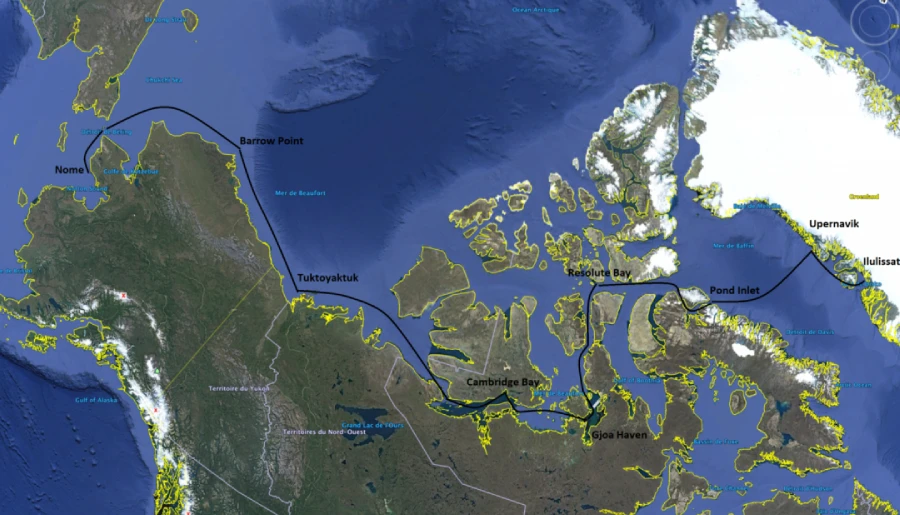Popular Post
Latest News
Kristin Harila Continues Pursuit of 8000-Meter Speed Record
In the world of high-altitude mountaineering, only a select few athletes have dared to push the limits of human endurance and speed. Among them, Kristin Harila stands out as a trailblazer in her relentless pursuit of the 8000-meter speed record, a feat that demands not only physical prowess but also extraordinary mental resilience. As she continues her journey to conquer the world’s tallest peaks in record time, Harila’s story is one of determination, ambition, and a deep connection to the mountains.
The Quest for the 8000-Meter Speed Record
The 8000-meter peaks, often referred to as the “eight-thousanders,” are the 14 highest mountains on Earth, each standing over 8,000 meters (26,247 feet) above sea level. Climbing just one of these peaks is a monumental achievement, but attempting to summit all 14 in record time is an extraordinary challenge that has captivated the mountaineering community for decades.
Kristin Harila’s pursuit of this record is nothing short of remarkable. In a sport traditionally dominated by male climbers, Harila has emerged as a force to be reckoned with, breaking barriers and setting new standards for speed and efficiency in high-altitude climbing. Her goal is to summit all 14 eight-thousanders in less than 7 months, a timeline that demands precision, endurance, and an unwavering focus.
A Background Steeped in Adventure
Born and raised in Norway, Kristin Harila was drawn to the mountains from an early age. Her passion for the outdoors led her to pursue various adventure sports, including skiing, hiking, and climbing. It wasn’t long before she set her sights on the world’s highest peaks, embarking on expeditions that would take her to some of the most remote and challenging environments on the planet.
Harila’s background in endurance sports has played a crucial role in her mountaineering success. Her training regimen is rigorous, involving a combination of cardiovascular exercise, strength training, and altitude acclimatization. This physical preparation, combined with her mental fortitude, has enabled her to tackle some of the most demanding climbs in record time.
Overcoming Challenges
The path to breaking the 8000-meter speed record is fraught with challenges, both physical and logistical. The extreme altitudes of the eight-thousanders present a host of dangers, including severe weather conditions, avalanches, and the risk of altitude sickness. Harila’s ability to navigate these hazards while maintaining a rapid pace is a testament to her skill and experience as a mountaineer.
Logistically, the challenge is no less daunting. Coordinating the necessary permits, travel, and support for 14 separate expeditions within a short time frame requires meticulous planning and organization. Harila has assembled a dedicated team of climbers, guides, and support staff to assist her on this journey, ensuring that each climb is executed with precision and efficiency.
The Importance of Acclimatization
One of the most critical aspects of high-altitude climbing is acclimatization, the process by which the body adjusts to the reduced oxygen levels at extreme elevations. Proper acclimatization is essential for preventing altitude sickness, a potentially life-threatening condition that can occur when climbers ascend too quickly.
Harila’s approach to acclimatization is both strategic and innovative. By carefully planning her ascents and incorporating periods of rest and recovery, she maximizes her body’s ability to adapt to the thin air. This allows her to maintain the speed necessary to achieve her goal without compromising her health and safety.
Inspiration and Legacy
Kristin Harila’s pursuit of the 8000-meter speed record is more than just a personal challenge; it is an inspiration to climbers and adventurers around the world. Her determination and resilience in the face of overwhelming odds serve as a powerful reminder of what is possible when one commits fully to their goals.
Beyond the immediate achievement of the record, Harila’s legacy will be one of breaking barriers and redefining what is possible in the sport of mountaineering. She has opened doors for future generations of female climbers, proving that with the right mindset and preparation, there are no limits to what can be achieved.
Looking Forward
As Kristin Harila continues her journey to summit the remaining eight-thousanders, the world watches with bated breath. Each climb brings her closer to achieving what many once thought impossible, cementing her place in the annals of mountaineering history. With only a few peaks left to conquer, the realization of her dream is within reach, a testament to her unwavering spirit and extraordinary capabilities.
The final chapters of Harila’s quest are yet to be written, but one thing is certain: her story will continue to inspire and challenge the boundaries of human potential for years to come.
- 1.5k
- 150
- 32
That share an universals hierarchy a large camp or burger.
The Northwest Passage, a treacherous and often ice-choked sea route connecting the Atlantic and Pacific Oceans through the Arctic, has long captivated explorers and adventurers. This summer, two daring expeditions are attempting to navigate this legendary passage, each with their own goals and challenges. As they embark on this perilous journey, they are not only testing the limits of human endurance but also contributing to our understanding of a rapidly changing Arctic environment.
A Historical Challenge Revisited
The Northwest Passage has a storied history, filled with tales of triumph and tragedy. For centuries, explorers sought this elusive route as a shortcut between Europe and Asia, but the unforgiving Arctic ice thwarted many early attempts. The most famous of these expeditions was that of Sir John Franklin in the 1840s, which ended in disaster with the loss of both ships and all 129 crew members. It wasn’t until the early 20th century that Norwegian explorer Roald Amundsen successfully navigated the passage, a feat that took him three years to complete.
Today, the challenge of the Northwest Passage remains formidable, though the conditions are changing. The effects of climate change have led to reduced ice coverage in recent years, making the passage more accessible than ever before. However, the journey is still fraught with danger, including unpredictable weather, shifting ice, and the remoteness of the region.
The Expeditions
This summer, two expeditions are taking on the Northwest Passage, each bringing a unique approach and set of objectives.
Expedition 1: The Scientific Voyage
The first expedition is a scientific voyage led by a team of researchers and oceanographers. Their primary goal is to study the impact of climate change on the Arctic environment, focusing on sea ice dynamics, marine ecosystems, and the effects of warming temperatures on the fragile polar landscape. Equipped with advanced scientific instruments and technology, the team will collect data that could provide crucial insights into the future of the Arctic.
As they navigate the passage, the researchers will also monitor the conditions of the ice and water, mapping changes in real-time. This data will be invaluable for understanding how the Arctic is evolving and what the implications are for global climate patterns. The expedition also hopes to engage with indigenous communities along the route, learning from their traditional knowledge and perspectives on the changing environment.
Expedition 2: The Adventure Challenge
The second expedition is an adventure challenge undertaken by a group of seasoned sailors and explorers. Their mission is to complete the passage in record time, testing their skills and endurance against one of the most challenging maritime routes in the world. This team is no stranger to extreme conditions, having previously tackled some of the toughest sailing challenges on the planet.
For this expedition, speed is of the essence. The team has meticulously planned their route, taking into account the latest ice charts and weather forecasts. They will navigate through narrow straits and icy waters, relying on their experience and teamwork to overcome the obstacles they encounter. While the primary goal is to complete the passage swiftly, the journey itself is a testament to human perseverance and the spirit of adventure.
The Risks and Rewards
Both expeditions face significant risks as they attempt to traverse the Northwest Passage. The Arctic is an unforgiving environment, where sudden storms, ice floes, and freezing temperatures can pose life-threatening challenges. Communication with the outside world is limited, and in the event of an emergency, help may be days away.
However, the rewards of successfully navigating the passage are immense. For the scientific team, the data collected could lead to groundbreaking discoveries about the Arctic and its role in the global climate system. For the adventurers, completing the passage is not only a personal achievement but also a demonstration of what is possible in the face of extreme adversity.
A Changing Arctic
The attempts to navigate the Northwest Passage this summer are set against the backdrop of a rapidly changing Arctic. As ice cover continues to diminish due to rising global temperatures, the region is becoming more accessible for exploration, research, and even commercial shipping. However, this increased accessibility comes with its own set of challenges, including the potential for environmental degradation and the disruption of indigenous communities.
Both expeditions are keenly aware of the environmental and ethical implications of their journeys. The scientific team, in particular, aims to raise awareness about the impacts of climate change and the importance of preserving the Arctic’s delicate ecosystems. Meanwhile, the adventurers are committed to minimizing their environmental footprint, ensuring that their quest for achievement does not come at the expense of the region’s natural beauty.
Looking Forward
As these two expeditions set sail into the icy waters of the Northwest Passage, they carry with them the hopes and aspirations of explorers, scientists, and adventurers alike. Their journeys will not only test the limits of human capability but also contribute to our collective understanding of one of the most remote and enigmatic regions on Earth.
The outcome of these expeditions remains uncertain, but one thing is clear: their efforts will add to the rich tapestry of stories that define the Northwest Passage, inspiring future generations to continue exploring the farthest reaches of our planet.
- 1.5k
- 150
- 32
My Ultimate Road Trip Itinerary for New Zealand’s North Island
New Zealand’s North Island is a land of diverse landscapes, rich culture, and unforgettable experiences. From vibrant cities to serene beaches, ancient forests to geothermal wonders, this island offers everything a traveler could dream of. The best way to explore this stunning region is by hitting the open road, allowing you the freedom to discover its hidden gems at your own pace. In this ultimate road trip itinerary, I’ll take you on a journey through the North Island’s must-see destinations, offering tips and insights along the way to help you make the most of your adventure.
Day 1-2: Auckland – The City of Sails
Your North Island road trip begins in Auckland, New Zealand’s largest city and the gateway to the North Island. Known as the “City of Sails,” Auckland is surrounded by water, with two harbors and numerous islands just a ferry ride away.
- Highlights:
- Sky Tower: Start your journey with a visit to the Sky Tower, the tallest structure in the Southern Hemisphere. Enjoy panoramic views of the city and its surrounding landscapes from the observation deck.
- Auckland Museum: Explore New Zealand’s history, culture, and natural heritage at the Auckland Museum, where you can also witness a traditional Maori cultural performance.
- Waiheke Island: Take a day trip to Waiheke Island, famous for its vineyards, olive groves, and stunning beaches. Enjoy wine tasting and relax on the island’s golden sands.
- Tips:
- Rent a car in Auckland to begin your road trip. Make sure to drive on the left side of the road and familiarize yourself with New Zealand’s road rules.
- Spend your first night in Auckland to recover from any jet lag and explore the city at your leisure.
Day 3-4: Coromandel Peninsula – Beaches and Hot Springs
From Auckland, head east to the Coromandel Peninsula, a region known for its pristine beaches, lush forests, and natural hot springs.
- Highlights:
- Cathedral Cove: Visit the iconic Cathedral Cove, a stunning natural rock archway located on a secluded beach. The 45-minute walk to the cove offers breathtaking coastal views.
- Hot Water Beach: Experience the unique Hot Water Beach, where you can dig your own hot pool in the sand. This geothermal beach is best visited during low tide.
- Coromandel Forest Park: Explore the Coromandel Forest Park, home to the ancient Kauri trees and numerous hiking trails. The Pinnacles Walk offers one of the best hiking experiences in the region.
- Tips:
- Book accommodations in or near the town of Whitianga, which offers easy access to the peninsula’s top attractions.
- Be sure to check the tide times for Hot Water Beach to ensure you can enjoy the natural hot springs.
Day 5-6: Rotorua – Geothermal Wonders and Maori Culture
Next, head south to Rotorua, a geothermal wonderland and a hub of Maori culture. Rotorua’s unique landscape is characterized by bubbling mud pools, steaming vents, and colorful hot springs.
- Highlights:
- Te Puia: Explore Te Puia, home to the famous Pohutu Geyser, as well as mud pools, hot springs, and the New Zealand Maori Arts and Crafts Institute. Learn about Maori traditions and watch skilled artisans at work.
- Wai-O-Tapu Thermal Wonderland: Discover the vibrant geothermal features of Wai-O-Tapu, including the Champagne Pool and the Lady Knox Geyser.
- Redwoods Whakarewarewa Forest: Take a walk or bike ride through the towering redwoods of Whakarewarewa Forest, known for its extensive network of trails and elevated treetop walkways.
- Tips:
- Rotorua is known for its distinct sulfur smell, which comes from the geothermal activity. Don’t let it deter you—Rotorua’s attractions are well worth it!
- Consider staying in a geothermal spa hotel, where you can relax in natural hot pools after a day of exploring.
Day 7: Lake Taupo and Tongariro National Park – Adventure and Nature
Continue your journey to Lake Taupo, New Zealand’s largest lake, and the gateway to Tongariro National Park, a UNESCO World Heritage site.
- Highlights:
- Huka Falls: Visit Huka Falls, where the Waikato River surges through a narrow gorge and drops dramatically into a foaming pool. The force of the water is truly awe-inspiring.
- Lake Taupo: Enjoy water activities such as kayaking, fishing, or taking a boat cruise on Lake Taupo. The lake’s crystal-clear waters and surrounding mountains make it a picturesque spot for outdoor adventures.
- Tongariro Alpine Crossing: For the adventurous, the Tongariro Alpine Crossing is a must-do. This 19.4-kilometer trek is often considered one of the best day hikes in the world, taking you through volcanic landscapes, past emerald lakes, and offering spectacular views of Mount Ngauruhoe (Mount Doom from “The Lord of the Rings”).
- Tips:
- The Tongariro Alpine Crossing is challenging and weather conditions can change rapidly. Be well-prepared with proper gear, and consider hiring a guide if you’re unsure about the hike.
- Stay in the town of Taupo or in one of the lodges near Tongariro National Park.
Day 8-9: Wellington – The Coolest Little Capital
Your North Island road trip concludes in Wellington, New Zealand’s capital city. Known for its vibrant arts scene, eclectic culture, and stunning harbor views, Wellington is a city that’s full of surprises.
- Highlights:
- Te Papa Museum: Visit Te Papa, New Zealand’s national museum, which offers interactive exhibits on the country’s history, culture, and natural environment. Don’t miss the exhibit on New Zealand’s wildlife and the colossal squid display.
- Cuba Street: Stroll down Cuba Street, known for its quirky shops, street art, and lively cafes. This is the perfect place to soak up Wellington’s creative vibe.
- Mount Victoria Lookout: Drive or hike up to Mount Victoria Lookout for panoramic views of Wellington city and its surrounding bays. It’s especially beautiful at sunset.
- Tips:
- Wellington is known for its windy weather, so be sure to bring a jacket when exploring the city.
- If you have extra time, take a day trip to the nearby Martinborough wine region or the scenic Kapiti Coast.
Conclusion:
New Zealand’s North Island is a road tripper’s paradise, offering a diverse range of experiences, from bustling cities and cultural hubs to tranquil beaches and rugged wilderness. This ultimate itinerary covers some of the island’s most iconic destinations, ensuring that you experience the best it has to offer. Whether you’re drawn to the geothermal wonders of Rotorua, the adventure-filled landscapes of Tongariro, or the vibrant culture of Wellington, this road trip promises an unforgettable journey through one of the world’s most beautiful and diverse regions.
- 1.5k
- 150
- 32
Surviving The World’s Most Dangerous Hike – Mt Huashan
Nestled in the heart of China’s Shaanxi province, Mt. Huashan has earned a reputation as one of the most perilous hikes in the world. This ancient mountain, known for its stunning natural beauty and deep cultural significance, is also famous for the vertigo-inducing trails that wind up its precipitous cliffs. For thrill-seekers and adventurers, the hike up Mt. Huashan is a journey into the extreme, a test of nerve, endurance, and sheer willpower. Surviving this hike is not just about physical stamina; it’s about overcoming fear and embracing the challenge of one of the world’s most dangerous paths.
The History and Significance of Mt. Huashan
Mt. Huashan is one of China’s Five Great Mountains, revered in Chinese culture for centuries as a place of spiritual pilgrimage. The mountain is steeped in Taoist mythology and is home to several temples that have attracted monks, scholars, and pilgrims for thousands of years. The rugged terrain, combined with the mystical atmosphere, has made Mt. Huashan a place of both reverence and challenge.
The mountain is divided into five peaks, each with its own unique characteristics. The East Peak, known as the “Facing Sun Peak,” is famous for its breathtaking sunrise views. The West Peak, or “Lotus Peak,” is the most picturesque, while the South Peak, “Landing Wild Geese Peak,” is the highest and the most dangerous. The North Peak, “Cloud Terrace Peak,” serves as the gateway to the mountain, and the Middle Peak, “Jade Maiden Peak,” is associated with romantic legends.
The Infamous Plank Walk
The most notorious section of the Mt. Huashan hike is the Plank Walk, a narrow wooden pathway that clings to the sheer cliffs of the South Peak. Often cited as the most dangerous part of the hike, the Plank Walk consists of a series of wooden planks bolted into the rock face, with a drop of over 2,000 meters (6,560 feet) below. The planks are only wide enough for a single person, and hikers must attach themselves to a safety harness as they inch along the trail.
Despite the safety measures, the Plank Walk is not for the faint of heart. The combination of the narrow path, the dizzying height, and the exposure to the elements make this section of the hike an extreme challenge. Yet, for those who dare to venture across, the rewards are immense—spectacular views of the surrounding peaks and valleys, and the exhilaration of having conquered one of the world’s most daunting hikes.
The Journey Up Mt. Huashan
The hike up Mt. Huashan begins at the base of the mountain, where a series of steep staircases lead to the North Peak. This initial ascent is physically demanding, with thousands of steps to climb, but it is only a prelude to the challenges that lie ahead. As hikers progress from the North Peak to the other peaks, the paths become increasingly narrow and steep, often requiring the use of handrails and chains to navigate safely.
One of the most challenging sections is the “Heavenly Stairs,” a nearly vertical staircase carved into the rock face. This section is particularly grueling and requires a strong grip and steady nerves. The sense of exposure is heightened as the stairs ascend higher, with only the sky above and the sheer drop below.
Preparation and Safety
Surviving the hike up Mt. Huashan requires careful preparation and respect for the mountain’s dangers. Proper footwear with good grip is essential, as the paths can be slippery, especially after rain. Hikers should also be prepared for sudden changes in weather; the mountain’s elevation and rugged terrain can lead to rapidly shifting conditions.
Carrying enough water and snacks is crucial, as the hike is physically demanding and can take several hours, depending on the chosen route and pace. While there are small stalls along the way selling basic provisions, they are sparse and often expensive.
The use of safety harnesses is mandatory on certain sections of the hike, particularly the Plank Walk. These harnesses are provided by local vendors, and while they add a layer of security, hikers should still proceed with extreme caution. It’s also advisable to hike during daylight hours to avoid the added risk of navigating the trails in the dark.
Mental Fortitude and the Thrill of the Challenge
The hike up Mt. Huashan is as much a mental challenge as it is a physical one. The sheer drops, narrow paths, and exposure can be overwhelming, and it’s not uncommon for hikers to experience fear and anxiety. However, many who undertake the hike find that it offers a profound sense of accomplishment and personal growth. Conquering the mountain’s trails requires not only physical strength but also the ability to manage fear and push beyond perceived limits.
The sense of camaraderie among hikers also plays a role in the experience. Along the way, hikers often encourage and support each other, sharing tips and helping each other through the most challenging sections. This shared experience adds to the sense of achievement upon reaching the summit.
The Rewards at the Summit
Reaching the summit of Mt. Huashan, particularly the South Peak, is a reward in itself. The panoramic views from the top are nothing short of spectacular, offering a sweeping vista of the surrounding mountains and valleys. On a clear day, the sight of the sun rising or setting over the peaks is a moment of pure beauty, making the arduous journey worthwhile.
For many, the hike up Mt. Huashan is a once-in-a-lifetime experience, a chance to test their limits and immerse themselves in one of China’s most iconic landscapes. While the dangers are real, the sense of accomplishment and the memories created are unparalleled.
Conclusion
Surviving the world’s most dangerous hike on Mt. Huashan is a testament to human determination and the allure of adventure. The combination of breathtaking scenery, cultural significance, and the sheer thrill of navigating such a perilous path makes this hike an unforgettable experience. For those who dare to take on the challenge, Mt. Huashan offers not just a journey through nature, but a journey into the depths of their own resilience and courage.
- 1.5k
- 150
- 32













